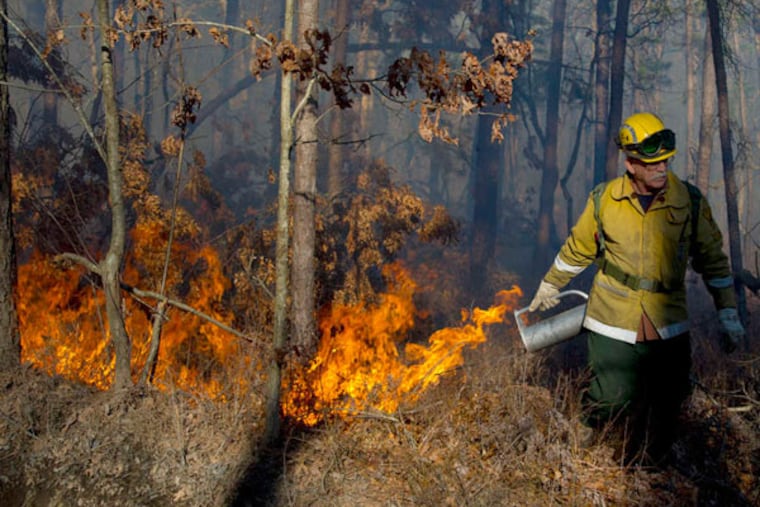Fighting fire with fire
The clouds of white smoke rising over the oak and pine forests of Maurice River Township, Cumberland County, on Monday alarmed some area residents and passersby. A few reported it to the local authorities and news media.

The clouds of white smoke rising over the oak and pine forests of Maurice River Township, Cumberland County, on Monday alarmed some area residents and passersby. A few reported it to the local authorities and news media.
But this Pinelands fire was never out of control.
It was purposely set - and carefully monitored - by the New Jersey Forest Fire Service as part of a plan to reduce heavy brush that might act as fuel for more destructive blazes in the wildfire season that begins this month.
The preemptive action is "even more important" this year because forests are choked with felled trees and debris caused by Hurricane Sandy, said Bob Martin, commissioner of the state Department of Environmental Protection.
"Prescribed burning is part of a planned strategy that the Forest Fire Service uses to manage natural fuels, including undergrowth and fallen branches and trees, which helps to reduce the size and severity of wildfires," Martin said. It helps "protect lives, property, and improve the overall health of our forests."
Monday's fire covered about 300 acres of the Peaslee Wildlife Management Area. Each year, the Forest Fire Service - part of the DEP's Forestry Services - burns from 10,000 to 15,000 acres of forests and grasslands, officials said.
These fires eliminate leaves, needles and brush, but do not reach the canopy of the forest or cause significant tree loss as wildfires do, said Ron Ruggeri, the Forest Fire Service's incident commander for Monday's burn.
"The fire stays low, and you see mostly white smoke," Ruggeri said. "It's like cleaning house."
Though the forests have ground debris every year, officials have noticed a greater problem this season.
"Many fully needled pine trees are on the ground in southern portions of the state, while larger, heavily leaved trees were felled in northern areas, providing potential major kindling for forest fires," said Steve Holmes, the DEP's supervising forest fire warden.
The prescribed burns are "just one practice that State Forestry Services relies on to maintain overall forest health," said State Forester Lynn Fleming.
"When combined with insect and disease treatments, habitat restoration, and carefully executed management plans, our forests will have a greater biodiversity of species, provide habitat for wildlife, and create safe recreation opportunities for residents," Fleming said.
The burns are carried out statewide by trained and experienced firefighters during the winter to minimize the amount of smoke produced and make use of weather conditions that tend to be safer for controlled fires, state officials said.
The work helps improve the habitat for wildlife, recycle nutrients into the soil, and enhance the appearance of the forest. Most of the burns occur on state-owned property, such as state forests and wildlife management areas, as well as other public lands.
State crews have been conducting burns since February at Stafford Forge, Greenwood and Peaslee wildlife management areas in Ocean and Cumberland Counties, and Brendan Byrne State Forest in Burlington County and Allaire State Park in Monmouth County.
"Humans and wildlife need fire in their forests, but it's when, where, how and how intense the fire is that determines its benefit or its negative impact," said certified forester Bob Williams, vice president of forestry operations at Land Dimensions Engineering in Glassboro. "Fires are coming, and we need to understand that, and work with Mother Nature, not against it."
Williams, who manages 100,000 acres of private forest across South Jersey, praised the New Jersey Forest Fire Service but said government needed to do more.
"Our fuel loads are building every year, and we are overdue for a really large fire that will result in significant loss of life and property," he said. "We will never burn our way out of this problem.
"This is the very reason we need to begin to manage our forest resources," he said. "Thinning trees and cutting brush can make a difference."